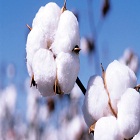
As per a recent report on Cotton Incorporated's Global Lifestyle Monitor, the cotton prices so far maintained at a higher level by market forces inside and outside of China are now declining, which it predicts could lead to drop in fabric and garment prices. The report says, decline in cotton prices around the world is because of the Chinese cotton policy reforms and expectations of large harvests outside China.
Reasons for price decline
Analytical approaches developed and implemented by Cotton Incorporated to forecast increases in sourcing costs following the cotton price spike in 2010-11 provides insight about future sourcing costs decreases. One approach, based on the fact that cotton garments are primarily composed of cotton fiber, utilizes garment weight. Publicly available data describing the count, weight, and value of apparel imports can be used to produce weight-based estimates of the effect of lower cotton prices. Multiplying a garment’s average weight by the change in cotton prices quantified in cents/lb produces a calculated per unit benefit from price decreases. These data suggest that the decrease in per unit costs could be larger for heavier goods, like denim jeans.

Calculated sourcing cost savings figures show the estimated effects due to fiber price changes alone. The percentage changes were derived as the relative difference between average import prices in 2013 and the estimated change in sourcing costs based on average product weights. Results from the analysis indicate that sourcing costs could decrease by 6 to 7 percent. In reality, upward pressure on costs from rising wages and other non-fiber costs like dyestuffs may partially offset decreases in sourcing costs made possible by lower cotton prices.
Over the last 10 years, there have been three instances when cotton prices declined more than 20 cents/lb within a six month period: following the financial crisis during the fall of 2009, after the wake of the 2010-11 price spike, and between the spring and fall of 2014. Average prices for cotton-dominant imports dropped after each of these periods when cotton prices decreased significantly. Examination of data about the relationship between fiber prices and cotton-dominant import prices reveals that the strongest statistical relationship between fiber prices and apparel import prices is seven months. Given a seven month lag between shifts in fiber prices and apparel import prices, analysis suggests that cotton import shipments arriving in late spring/summer 2015 should fully incorporate the effects of recent decreases in fiber prices.
China's cotton stockpiling policy and its effects
Changes in China’s cotton policies have paved the way for full decrease in prices that could have been expected with the massive accumulation of global stocks that followed the 2010-11 spike in prices. Current estimates suggest that China holds more than 60 per cent of global warehoused supply and Chinese cotton stocks are nearly six times larger than before the establishment of the government’s price guarantee policy. Due to reforms in Chinese government cotton policies, the reserve system will no longer function as such a dominant force of demand.
Going forward, the world market can view China’s reserve system as a source of supply since it will no longer be making purchases and could be expected to sell eventually from its accumulated supplies.
Also increases in projected forecasts for cotton harvest in other major cotton producing countries, notably India and the US, may further impact prices. The current forecast indicate that India’s production will match its own record of 31.0 million bales in 20140-15 and that the country will surpass China as the world’s largest cotton grower – a title that China has held since the 1980s. Improved rainfall conditions in cotton growing regions within the US, specifically West Texas, have led to higher production forecasts and expectations that have helped push NY Futures and A Index cotton prices lower. Higher production forecasts in exporting countries like the US and India imply that more cotton supply will be available to the world market at lower prices. Lifestylemonitor.cottoninc.com












